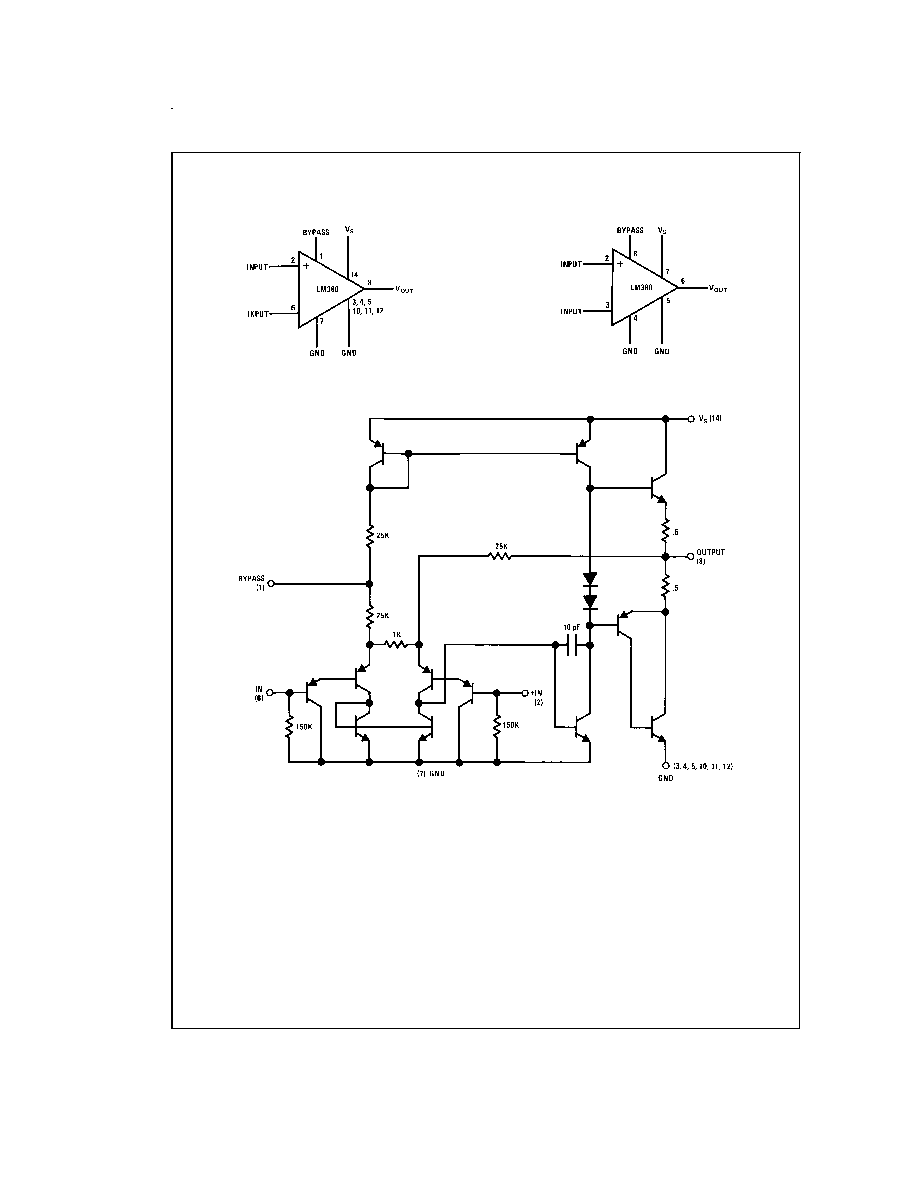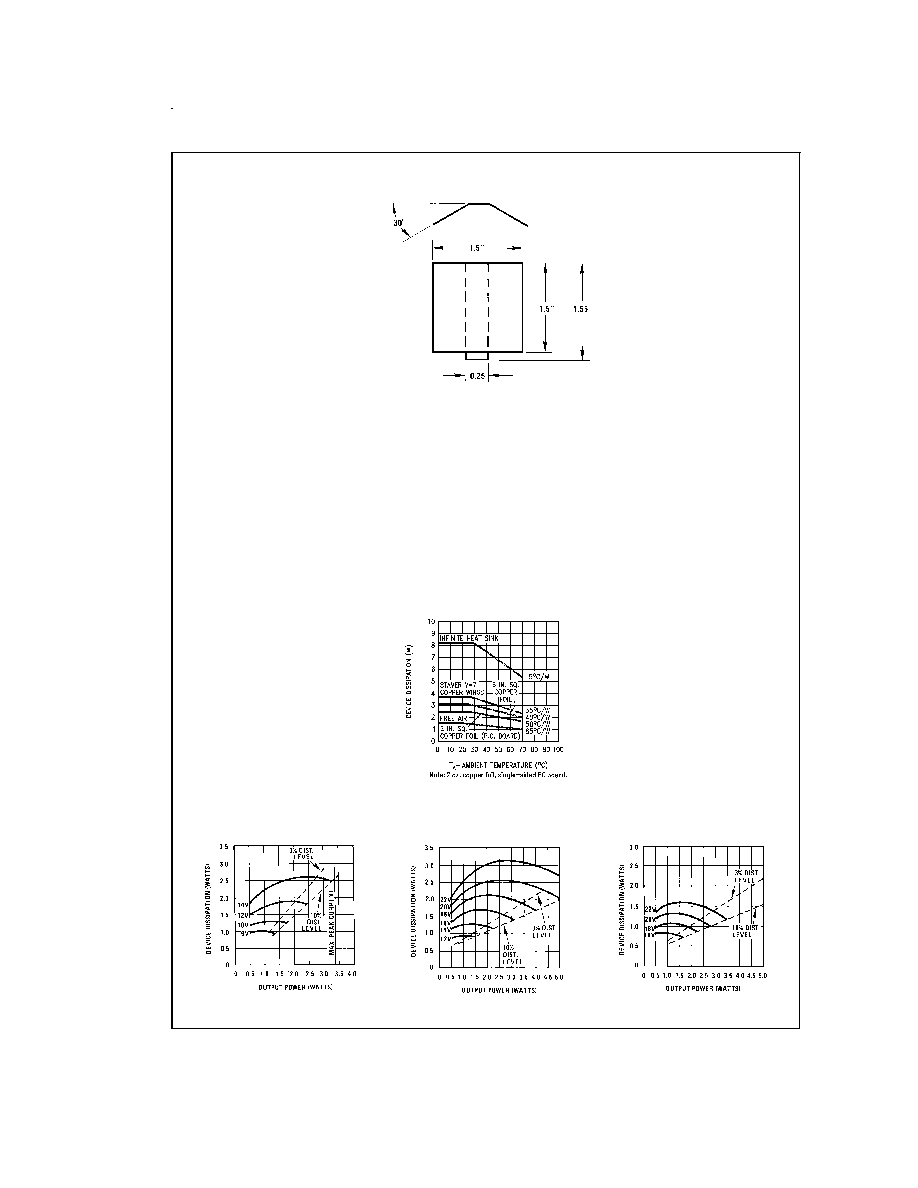
LM380
Audio Power Amplifier
General Description
The LM380 is a power audio amplifier for consumer applica-
tion. In order to hold system cost to a minimum, gain is inter-
nally fixed at 34 dB. A unique input stage allows inputs to be
ground referenced. The output is automatically self centering
to one half the supply voltage.
The output is short circuit proof with internal thermal limiting.
The package outline is standard dual-in-line. A copper lead
frame is used with the center three pins on either side com-
prising a heat sink. This makes the device easy to use in
standard p-c layout.
Uses include simple phonograph amplifiers, intercoms, line
drivers, teaching machine outputs, alarms, ultrasonic driv-
ers, TV sound systems, AM-FM radio, small servo drivers,
power converters, etc.
A selected part for more power on higher supply voltages is
available as the LM384. For more information see AN-69.
Features
n
Wide supply voltage range
n
Low quiescent power drain
n
Voltage gain fixed at 50
n
High peak current capability
n
Input referenced to GND
n
High input impedance
n
Low distortion
n
Quiescent output voltage is at one-half of the supply
voltage
n
Standard dual-in-line package
Connection Diagrams
(Dual-In-Line Packages, Top View)
DS006977-1
Order Number LM380N
See NS Package Number N14A
DS006977-2
Order Number LM380N-8
See NS Package Number N08E
December 1994
LM380
Audio
Power
Amplifier
� 1999 National Semiconductor Corporation
DS006977
www.national.com

Block and Schematic Diagrams
LM380N
DS006977-3
LM380N-8
DS006977-4
DS006977-5
www.national.com
2

Absolute Maximum Ratings
(Note 1)
If Military/Aerospace specified devices are required,
please contact the National Semiconductor Sales Office/
Distributors for availability and specifications.
Supply Voltage
22V
Peak Current
1.3A
Package Dissipation 14-Pin DIP (Note 7)
8.3W
Package Dissipation 8-Pin DIP (Note 7)
1.67W
Input Voltage
�
0.5V
Storage Temperature
-65�C to +150�C
Operating Temperature
0�C to +70�C
Junction Temperature
+150�C
Lead Temperature (Soldering, 10 sec.)
+260�C
ESD rating to be determined
Thermal Resistance
JC
(14-Pin DIP)
30�C/W
JC
(8-Pin DIP)
37�C/W
JA
(14-Pin DIP)
79�C/W
JA
(8-Pin DIP)
107�C/W
Electrical Characteristics
(Note 2)
Symbol
Parameter
Conditions
Min
Typ
Max
Units
P
OUT(RMS)
Output Power
R
L
= 8
, THD = 3% (Notes 4, 5)
2.5
W
A
V
Gain
40
50
60
V/V
V
OUT
Output Voltage Swing
R
L
= 8
14
V
p-p
Z
IN
Input Resistance
150k
THD
Total Harmonic Distortion
(Notes 5, 6)
0.2
%
PSRR
Power Supply Rejection Ratio
(Note 3)
38
dB
V
S
Supply Voltage
10
22
V
BW
Bandwidth
P
OUT
= 2W, R
L
= 8
100k
Hz
I
Q
Quiescent Supply Current
7
25
mA
V
OUTQ
Quiescent Output Voltage
8
9.0
10
V
I
BIAS
Bias Current
Inputs Floating
100
nA
I
SC
Short Circuit Current
1.3
A
Note 1: "Absolute Maximum Ratings" indicate limits beyond which damage to the device may occur. Operating Ratings indicate conditions for which the device is
functional, but do not guarantee specific performance limits.
Note 2: V
S
= 18V and T
A
= 25�C unless otherwise specified.
Note 3: Rejection ratio referred to the output with C
BYPASS
= 5 �F.
Note 4: With device Pins 3, 4, 5, 10, 11, 12 soldered into a 1/16" epoxy glass board with 2 ounce copper foil with a minimum surface of 6 square inches.
Note 5: C
BYPASS
= 0.47 �fd on Pin 1.
Note 6: The maximum junction temperature of the LM380 is 150�C.
Note 7: The package is to be derated at 15�C/W junction to heat sink pins for 14-pin pkg; 75�C/W for 8-pin.
www.national.com
3

Heat Sink Dimensions
Typical Performance Characteristics
DS006977-6
Staver Heat Sink #V-7
Staver Company
41 Saxon Ave.
P.O. Drawer H
Bayshore, NY 11706
Tel: (516) 666-8000
Copper Wings
2 Required
Soldered to
Pins 3, 4, 5,
10, 11, 12
Thickness 0.04
Inches
Maximum Device Dissipation vs
Ambient Temperature
DS006977-12
Device Dissipation vs Output
Power -- 4
Load
DS006977-13
Device Dissipation vs Output
Power -- 8
Load
DS006977-14
Device Dissipation vs Output
Power -- 16
Load
DS006977-15
www.national.com
4

Typical Performance Characteristics
(Continued)
Typical Applications
Power Supply Current vs
Supply Voltage
DS006977-16
Total Harmonic Distortion
vs Frequency
DS006977-17
Output Voltage Gain and
Phase vs Frequency
DS006977-18
Total Harmonic Distortion
vs Output Power
DS006977-19
Device Dissipation vs
Output Power
DS006977-20
Supply Decoupling vs
Frequency
DS006977-21
Phono Amplifier
DS006977-8
Bridge Amplifier
DS006977-9
www.national.com
5




